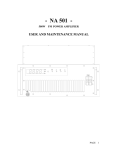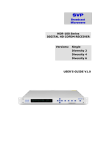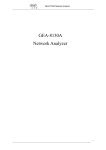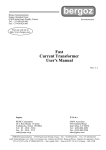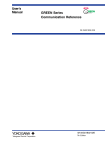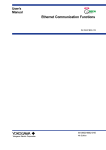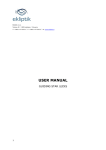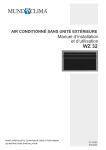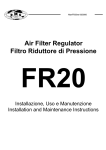Download NA2001 - 3
Transcript
- NA2001 2.0 KW FM POWER AMPLIFIER USER AND MAINTENANCE MANUAL NICOM USA NA2001 - USER AND MAINTENANCE MANUAL - CONTENTS 1 GENERAL DESCRIPTION ................................................................................... 3 2 TECHNICAL FEATURES ..................................................................................... 4 2.1 FRONT PANEL COMMANDS AND SIGNALLING ................................ 4 2.2 REAR PANEL AND THE CONNECTIONS .............................................. 6 2.3 I/O REMOTE CONTROL SPECIFICATIONS ........................................... 8 2.4 TECHNICAL SPECIFICATIONS ............................................................... 9 3 INSTALLATION AND USE ................................................................................ 10 3.1 FOREWORD TO INSTALLATION ........................................................ 10 3.2 PLACING THE APPARATUS .................................................................. 11 3.3 WIRING INTO THE MAINS .................................................................... 11 3.4 ANTENNA CONNECTION ....................................................................... 12 3.5 LF CONNECTION ..................................................................................... 12 3.6 OTHER RECOMMENDATIONS ............................................................. 13 3.7 IMPORTANT NOTE RE: VENTILATION .............................................. 13 3.8 OPERATION ................................................................................................ 14 4 SERVICE AND MAINTENANCE ...................................................................... 16 5 WARRANTY .......................................................................................................... 16 6 SERVICE MANUAL ............................................................................................. 17 6.1 SYSTEM DESCRIPTION .......................................................................... 17 6.2 INTERNAL DESCRIPTION ..................................................................... 18 7 REPAIR AND REPLACEMENT OF DAMAGED MODULES ...................... 25 A.1 A.2 DRAWINGS NA2001 amplifier front & top view (D0923) ...................................................... NA2001 amplifier, rear and side view (D0923) ................................................... NA2001 amplifier, top internal assembly view (D0945) ....................................... NA2001 amplifier, bottom internal assembly view (D0946) ................................. NA2001, general electric diagram (E0855) ....................................................... SRFB1K0PS, power supply controller board diagram and layout (E0856) .... SRFB1K0CON, controller and meter board diagram and layout (E0761A) ... SRFB1K0PRO, control, interface & protection board diagram and layout (E0860) SRFB1K5ALM, 48V/70A SMPS regulator module diagram and layout ......... SRFB1K0CM, current monitor board diagram and layout (E0861) ................. RFB2001S, 1000W RF amplifier assembly electric diagram (E0857) ............. SRFB1K0IN, 2-port RF input splitter diagram and layout (E0858) ................. SRFB500W, 500W amplifier module diagram and layout (E0764) ................. SRFB1K0PB, 2-port RF output combiner & LPF diagram and layout (E0859) PAGE 2 NA2001 - USER AND MAINTENANCE MANUAL - NA 2001 2.0kW 1 FM POWER AMPLIFIER GENERAL DESCRIPTION The NA2001 is a highly integrated broadband solid-state Mos-Fet FM amplifier of 2000W rated power, fitted in a 16 unit 19" rack, which provides room eitherfor the exciter and some spare equipment Its compact size, high efficiency, wide AC range acceptance, low maintenance requirements and broadband construction, make this amplifier ideal in medium power repeaters, in unattended posts, in N+1 systems and as a reserve. Its sturdy, modular mechanical and electrical construction guarantees a high MTBF and an easy maintenance. The modules are easily identifiable a can be inspectedle with w disconnectionns each other, through multi-pole connectors. The nominal RF output power is obtained over the full FM range with a mere 12W drive and is particularly stable through time, temperatur,e and frequency variations being ALC regulated, with a front panel adjustment. The output power may be varied from a minimum level to the nominal level and the frequency varied over the full FM range, without re-adjust the drive power or any other adjustment than the ALC control. The output stage has a reverse intermodulation figure, which is lower than standard bipolar construction, due to the all Mos-Fet design that approaches that of tube equipment. A particular metering and alarm section completes the amplifier, allowing an easy check of the functioning with unambiguous readings. All main parameters and alarms are externally available on a remote I/O port, which allo to command stand-by/on-the-air operating mode, with a fraction of a second reaction time. A suitable external controller may be supplied on request to allow full remote control of the apparatus from the studio or anywhere elsePower consumption n in stand-by mode is <10W. All the input and output ports are fitted on the rear. The exhaust air too is conveyed on the rear: an optional flanged outlet can be mounted to provide a connection to an external ventilation system. The whole assembly is designed in accordance with the CCIR, FCC and tighter international rules and conforms to the recent, strict CE requirements for EM acceptancee and emission. This Equipment complies with and ETSI 300.384 requirements. PAGE 3 NA2001 - USER AND MAINTENANCE MANUAL - 2 TECHNICAL FEATURES 2.1 FRONT PANEL COMMANDS AND SIGNALLING The front control panel contains all the metering facilities, with a fixed RF power meter, a switchable one, a "STATUS / ALARM" section and the "ON / STAND-BY" control and signalling section. The switchable meter allows the reading of the reflected power (340W f.s.)(f.s=full scale), the regulated current and voltage (60Adc and 60Vdc f.s.), the auxiliary regulated voltage (25Vdc f.s.), the unregulated voltage and the input voltage (250Vdc and 250 Vac f.s.). The switching between the different measures is made by pushing on the "MEASURE" switch. The time between the first measure ( reflected power) and the second one is 3 times as long as the others and this measure is the default reading when we turn on the unit. The "STATUS" section shows regular or alarm modes: the first LED column on the left must be always on with green light during regular "on the air" operation and becomes red in case of warning. The second column red lights are on only in case of failure. The Key to the various LED's is summarized on table 1. PAGE 4 NA2001 - USER AND MAINTENANCE MANUAL - LED GREEN RED OPERATION Regular functionment Alarm RF POWER reg./der. Regular RF reduced for any internal safety reason RF POWER reg./low Regular RF lower than approx. -3dB (≈500 W) POWER SUPPLY Regular Low regulated voltage (<≈42 Vdc) ON THE AIR Regular Blocked for any continuous safety reason Needs manual reset MAINS HIGH High input mains voltage (> 250 Vac) MAINS LOW Low input mains voltage (< 190 Vac) VSWR High RF output refl. power (> 100 W) TEMPERATURE High internal temperature CURRENT High current absorbtion (> 80 A) Table 1: Status led meaning The "ON" and "STAND-BY" LED's on the last section clearly give the corresponding operating mode. Note that "on" does not means "on-the-air", but simply that the amplifier is completely powered and ready to deliver power if correctly driven. The "on" state is the default state when the NA2001 is switched on by the main switch, and turns to "stand-by" by pushing on the "local" switch, which will light. Remotely commanding stand-by mode will do the same, and the remote control is signaled by its small yellow LED. Local and remote commands both act in parallel to force the equipment in stand-by. During stand-by operations, only the command interface section is active. The auxiliary regulated voltage is on, while the main regulated power supply and all the fans are off. The RF output power may be adjusted by the front panel trimmer without retouching the drive power, which is usually set at 20W, i.e. a value which is only slightly higher than that needed to drive the amplifier at full power. RF Output range in this condition is between 1/5 and full power. If a very low power operation is needed ( down to zero), it can be achieved by slightly reducing the input power. PAGE 5 NA2001 - USER AND MAINTENANCE MANUAL Resetting the unit can be done, if needed, with a small pointed object, through a hole in the panel. This alarm-reset pushbutton must be manually pushed if the module is locked for any reason, for repeated or prolonged action of any protection, mainly for very high VSWR or high input power. The reset can also be remotely applied through the remote I/O port. 2.2 THE REAR PANEL AND THE CONNECTIONS The rear panel allocates all the RF and the I/O ports in addition to the AC power cord, the grounding screw and the on/off switch. The output connector is a 7/8 EIA connector, while the input connector is an"N" type. At the RF monitor output (BNC type), a sample of the output power is available, which is attenuated 54 dB typically (i.e. +6 dBm @ 2 kW output). Even if this output is fairly flat vs. frequency, it is not suggested to use this for accurate harmonic analysis. The AC power cord goes through this panel, which is not removable. If it is required, a longer cable than the one supplied from the factory (about 7 foot long), a suitable 3x 2.5 mm sq. power cord may PAGE 6 NA2001 - USER AND MAINTENANCE MANUAL easily replace the original one. The remote I/O port (SUBD 25 poles, female) and the exhaust air output opening are fixed directly on the panel. Wide room must be provided during installation to allow ventilation air flux, which must not be obstructed. It is not advisable to insert the equipment in a rack without a suitable fan. An optional exhaust air flanged outlet may be required and mounted to facilitate the connection to an external ventilation system An auxiliary IEC-320 female type AC outlet is provided. This is powered only when the amplifier is on (enabled), i.e. not in stand-by mode. The exciter is usually connected to this outlet, and is powered only when the apparatus is fully on. A separate power connection is used if the exciter may be switched to stand-by/operation by the logic signal available on the I/O remote connector (see later), thereby avoiding any delay to lock in frequency nor delivering power to the amplifier during stand-by. No fuses other than the general fuses (16A) are inserted on this line. They limit the power absorption from this outlet to low levels, i.e. 100W / 1A max. , WARNING ! To access the inside of the unit for changing fuses, the top cover must be removed. Be sure to remove the power cord from AC supply to avoid direct exposure to hazardous AC voltage, which are always present on the fuses and the input board, even with power switch in the off position. PAGE 7 NA2001 - USER AND MAINTENANCE MANUAL - 2.3 I/O REMOTE CONTROL SPECIFICATIONS The remote I/O DB25 female connector, located on the rear panel, makes available several analog and digital connections to allow remote control and surveillance of the equipment. The assigned lines to each connector pin are: Pin 1 2 3 4 5 6 7 8 9 10 11 12, 24 13, 25 14 15 16 17 18 19 20 21 22 23 Line ground Stand-by n.c. / ground Regular/Alarm RF Derate VSWR Alarm Current Alarm Block Alarm Reflected Power Range/use common connect to ground to stand-by +12V when Alarm (Cmos out) +12V when RF power derated on protection (Cmos out) +12V when high VSWR on antenna line (Cmos out) +12V when dc Current too high (Cmos out) closed to ground when regular (100mA/24Vmax relay contact) 0/5V vs. 0/340Wout (Op-Amp out, Zo=156Ω) (2.71 V typ. @ 100W) Forward Power 0/5V vs. 0/2.5kWout (Op-Amp out, Zo=156Ω) (3.16 V typ. @ 1000W / 3.87 V typ. @ 1500W) ground signal ground Aux. supply out +12.5Vdc / 100mAout, protected by fuse ground power ground Reset Close to ground to reset Block Alarm for T>0.2 sec Enable out open/close an internally programmable relay contact to ground ground signal ground RF low +12V when RF low, i.e. < ≈700Wout (Cmos out) P. Supply Alarm +12V on Power Supply Regulator alarm (Cmos out) Temper. Alarm +12V when too high Temperature (Cmos out) Mains alarm +12.5V when Mains line is out of range (Cmos out) n.c. / ground future option Regulated Volt. 0/5V vs. 0/50V out on Power Supply Regulator (Zo≈300Ω) Regulated Cur. 0/5V vs. 0/100A out from P. S. Regulator (Op-Amp out, Zo=156Ω) WARNING: Never connect anything to the Remote I/O connector with power supply on. Damage or overload to any buffered line may cause improper function or measure on the equipment. The remote I/O signal and control DB25 female connector, on the rear panel PAGE 8 NA2001 - USER AND MAINTENANCE MANUAL - 2.4 TECHNICAL SPECIFICATIONS @ 2kW RF output - Frequency range: 87.5 / 108 MHz - RF input power 20 W nom., 25 W max - RF output power 2000 W ±0.5 dB - RF input/output impedance: 50 Ω - RF input connector: N - RF output connector: 7/8 EIA - RF monitor connector: BNC - Harmonic and spurious emissions: < -70 dBc - RF monitor attenuation: 54 dB, typ. - Max total current handling capability on the auxiliary sockets: 1A @ 230 Vac, 100Wmax, not fused - AC requirements: Single phase 220-240V ac. 50/60Hz<3800W (5000VA) - Operating temperature range: 0 / +35 °C recommended, -10 / + 50 °C max - Dimensions, not including handles: 19" x 12" x 22" (483 x 310 x 570 mm )(H x W x L) See drawings - Weight, not including the exciter: 103 Lbs (47 kg), approx. REMOTE CONTROLS: Stand-by, Alarm Reset, Exciter enable REMOTE SIGNALS: Alarm, Power derating, Power low, High VSWR, Power supply fault, Current alarm, Temperature alarm, AC alarm, System block REMOTE MEASURES: Forward and Reflected power, Regulated Power Supply current and voltage PAGE 9 NA2001 - USER AND MAINTENANCE MANUAL - 3 3.1 INSTALLATION AND USE INSTALLATION Although in most cases no special instruments are required, skilled personnel should install the amplifier. To get the best performance and prevent damage to the unit, comply with the recommendations throughout this manual. When in doubt , or if any technical problem should arise during the installation procedure, NICOM strongly recommends not to tampering with the unit by unskilled personnel and will be glad to offer qualified after-sale service. As a rule, the user should not need access to the inside of the apparatus for normal installation and use. Tampering with the unit without any authorization from the factory makes the warranty void and might also affect the future performance, causing costly damages. , WARNING ! NO ADJUSTMENT OR INTERNAL PRESETTING IS REQUIRED FOR NORMAL OPERATIONS. THE APPARATUS SHALL BE PROPERLY GROUNDED AND OPERATED WITH ALL THE COVERS CLOSED TO PREVENT ELECTRICAL HAZARDS IN OPERATION AND FULLY COMPLY WITH SAFETY REQUIREMENTS. NEVER TOUCH THE INSIDE OF THE UNIT WITHOUT FIRST DISCONNECTING IT FROM THE AC. DANGEROUS AC, DC AND RADIO-FREQUENCY VOLTAGES ARE PRESENT INSIDE AND BECOME ACCESSIBLE WHEN THE COVERS ARE REMOVED. ——— AC VOLTAGE MAY KILL ——— 3.2 PLACING THE AMPLIFIER PAGE 10 NA2001 - USER AND MAINTENANCE MANUAL Place the amplifier in a dry, sheltered, but well-ventilated room away from dust, moisture, insects and other animals. Place it as close as possible to the antenna to prevent excessive power loss in the cables. If this is not possible, use antenna cables of suitable cross-section. Room size should be such that the unit can be placed in an upright position and so that technical personnel can easily carry out routine or extraordinary maintenance. The minimum recommended size is 50 square feet if no other broadcasting or support equipment are nearby. The room must be ventilated to ensure that the inside temperature never exceeds 35°C. Even if 50°C is the max. allowed temperature: it is wise to stay under 35°C as a rule for normal operation. This condition cannot generally be met unless the exhaust cooling air is pushed outside and fresh air is fed back into the room. This is even truer if more than one apparatus is installed in the same location. An efficient ventilation system is thus required in the room. Air exchange in the room shall have a minimum flow-rate of 500 metres cubed per hour or more. If the apparatus is fitted in a rack system, the back door of the rack has to be left free from obstacules. If a completely closed assembly is needed, a suitable ventilation extraction unit must equip the system. To aid air flow, an optional flange may be retrofitted on the ventilation outlet to which a duct can be attached to convey hot air outside. In this case remember that the NA2001 internal fans are lowpressure units: some sort of external air extraction blower is then imperative on the exhaust air duct. Vents in the walls and any other openings shall be fitted with a metal grating to keep rodents out, and with a dust filter. Make absolutely certain that no water can seep through the vents or the air exhaust duct or antenna-cable grommet, and that the floor cannot be flooded during heavy rainfalls. Moisture and/or dust, when contained in the air or in the room in excessive quantity, may cause condensation build-up in the amplifier. When the system is periodically switched on and off, this can trigger destructive electric arcs and short circuits and thus cause damage that is not covered by the warranty. 3.3 WIRING INTO THE AC The NA2001 is powered by a single-phase line. Mains capacity must be at least 5kVA and the nominal voltage is 230 Vac. PAGE 11 NA2001 - USER AND MAINTENANCE MANUAL Also if the power supply regulator accepts a wide input voltage (190 / 250 Vac), operation near the lower input voltage on high impedance lines must be avoided: if the line drops more than 6 volts at full load, the low line sense circuitry may trigger an oscillating turn-on / turn-off cycle, which is very dangerous. In this cases adopt an external line stabilizer. The nominal AC input range (190 ÷ 265 Vac) is achieved when the primary side of the main transformer is wired to the 230 V tap. Two other taps, the first one slightly lower (220 V), the second higher (240 V), are available to adjust the input voltage range of ±10 V. In countries where a stable 240V is the norm, it is important to set this tap on the transformer. In this case the allowed voltage range window must be shifted higher to avoid nuisance trip at an occasional higher input voltage. See proper section in the service section of this manual. To ensure proper operation and comply with the safety regulations, efficient grounding is required. Use the yellow/green lead in the power cable. The cable’s neutral lead is blue. Never connect the ground to the AC’ neutral lead. The cable connecting the NA2001 AC input terminal block to the external board should consist of leads of adequate size. Recommended values are 2.5 to 4 mm squared. Never switch the apparatus on without antenna connection, or dummy load, even when no RF drive is on. 3.4 ANTENNA CONNECTION A 7/8 EIA output connector is fitted at the back of the amplifier module. It is very important to check that the antenna, the connecting cables and the connectors are suitable for 2.0 kW. The antenna coupler too, should be capable of adequate power; its input connector shall be 7/8" or larger. The cable connecting the amplifier and antenna will generally be of the corrugated, spongy-dielectric type, such as a 1/2" or 7/8" celflex or flexwell. Smaller cables as RG214, cannot be used. The antenna shall be grounded via a copper braid of adequate section to prevent lightning reaching the amplifier via the antenna cable. 3.5 LF CONNECTION To maximally avoid ground loops, wire the modulation signal line directly on the exciter, with high quality shielded and preferably balanced cable. Ground the shield only on the exciter LF input If balanced lines are not possible, use the highest available level of cable PAGE 12 NA2001 - USER AND MAINTENANCE MANUAL - 3.6 OTHER RECOMMENDATIONS The ambient temperature shall be between 0°C and +30°C (35°C max. peak). It is advisable to hang a min.-max thermometer on the wall to display any variation. Air conditioning at 20 / 25°C would obviously be the best solution, but installation and operating costs are generally excessive. Thermal isolation and efficient ventilation with a thermostat-controlled blower are generally the best solution. AC fluctuation and electric discharges due to the weather or nearby industrial machinery may cause significant trouble, especially in mountain areas and in places close to industrial areas. In such cases, it is advisable if not indispensable, to install a protector, and insulating transformer or possibly an electromechanical mains voltage regulator. Budgets could incluce all necessary protective gear to adequately shield antenna and transmitting systems. The use of these protections will allow the units to operate in very good condition, increasing the life of the unit itself and, above all, avoiding accidental breakdowns due to ambient or AC trouble. , 3.7 !! WARNING !! IMPORTANT NOTE FOR VENTILATION It is mandatory to provide adequate ventilation to the apparatus to maintain its internal temperature as low as possible, in the recommended range 5 / 25°C. Even if the apparatus may sustain 50°C, and occasionally slightly higher temperatures, its life expectancy will be shortened by high temperature. As general rule the life expectancy may be halved by each 10°C increase in ambient temperature, over 30°C. PAGE 13 NA2001 - USER AND MAINTENANCE MANUAL - 3.8 OPERATION Make certain that the antenna or a suitable dummy load is connected to the amplifier RF output, and verify that the power cord is connected to the proper auxiliary AC outlet, as explained in the previous section "REAR PANEL AND CONNECTIONS". Check that the exciter output signal is fed to the amplifier input and the correct frequency is set, then: 1) Reduce exciter power to 0. 2) Reduce amplifier power to the minimum by completely rotating the proper trimmer on the amplifier module's panel. 3) Push down the control panel "LOCAL" switch: it must hold down. 4) Switch-on the rear power-on switch. The NA2001 will turn-on in stand-by mode. - Some LED's will light in green on the control panel, i.e. OPERATION, RF POWER reg./ derated, ON THE AIR. - Some LED's will light in red, i.e. RF POWER reg./low, POWER SUPPLY. - The measure module will start in the "reflected power" position. 5) Push down the "LOCAL" switch to release it: the NA2001 will turn to the "ON" state. - The POWER SUPPLY LED must turn to green. - Internal blowers will start. - The exciter must switch-on (if not, control its power switch!) and must lock on frequency after some seconds. - No RF output power. 6) Raise the drive power to the required level, usually 20 W at the input of the amplifier. - The RF output power can rise from zero to 100 / 200 Watt. 7) Slowly increase the preset power by the proper trimmer on the amplifier front panel, until reaching the required output power, not higher than 2050 W. - Roughly at 700 W, the RF POWER LED on the control panel will change to green - At the same time the green RF REGULAR LED on the amplifier module will light. 8) Check and note for future reference the correct reading of the operating parameters through the internal meter, which must indicate the following values: - FORWARD POWER: REFLECTED POWER: REGULATED CURRENT: REGULATED VOLTAGE: AUXILIARY VOLTAGE: up to 2050W < 50 W < 75 A 48 V 12.5 V PAGE 14 NA2001 - USER AND MAINTENANCE MANUAL - UNREGULATED VOLTAGE: - AC VOLTAGE: 120 / 170 V 200 / 245 V The installation of the amplifier is thereby completed. A spectrum analysis is now advisable to assure no spurious products due to internal or external causes (i.e. reverse intermodulation on the final stage) are generated. NICOM wishes you success in your work and reminds you that they are always available for further information or to tackle any specific problem. , WARNING ! OPERATION WITHOUT THE ANTENNA OR WITH A FAULTY ANTENNA CONNECTION MAY CAUSE DEGRADATION AND POSSIBLE DESTRUCTION OF THE FINAL STAGE. THIS FAILURE IS NOT COVERED BY NICOM WARRANTY. PAGE 15 NA2001 - USER AND MAINTENANCE MANUAL - 4 SERVICE AND MAINTENANCE Since the NA2001 is cooled by air, it is subject to clogging by dust. Because of the high-quality materials used in the manufacture, if it is installed following the “INSTALLATION AND USE,” it will not require special maintenance for quite some time. A regular service routine, mainly to remove internal dust is suggested every 6 months. Keep in mind that 90% of the air circulation is restricted to the main internal ventilation channel and does not affect the components. Regularly change the ventilation fan, especially in higher temperature environments. A 2-year period may be safe: always use the same high quality, ball bearing fan type. After a few years of continuous service, it is recommended that the unit return to the factory or in a specialized lab, where the specs can be verified and recalibration can be made if needed. It is also very important that the power supply be over-hauled when the unit has been working at high temperatures, over 30 / 35°C. 5 WARRANTY Like all NICOM's solid state equipment, the NA2001 carries a two-year guarantee on all its components with the exclusion of the final RF power module, which may be damaged by faulty output connections. This warranty is void if the amplifier is tampered or if failure is due to improper use, wrong installation or external causes, such as mains overvoltage. This warranty covers work done exclusively in our laboratories . The goods shall be shipped prepaid to the laboratory and shall be returned freight collect. This warranty does not cover any consequential damage due to non-operation or faulty operation. PAGE 16 NA2001 - USER AND MAINTENANCE MANUAL - 6 6.1 SERVICE MANUAL SYSTEM DESCRIPTION 3 basic sections compose the NA2001: the RF amplifier box, the power supply and the control and metering section. The RF section includes 4 x 500W amplifier modules connected through strip-line combiners. All the RF transistors are Mos-Fet type. A low-pass filter with directional coupler completes the section, which is completely screened by a metal box, to comply with EMI requirements. A fully planar design allows immediate access and inspection to the 4 internal modules. The power supply includes a AC input screened transformer, whose output is rectified and filtered and a highly efficient Switch-Mode Power Supply regulator. A separate power supply controller provides input filtering and voltage range check. The control section is made of two boards. The first one performs full RF AGC and protection control; the other provides metering and an interface to the external I/O port. All main parameters such as Voltages, Currents, Direct and Reflected Power and protections are displayed and provided at the Remote I/O port. Through this port it is possible to command the stand-by / on-the-air operating mode. NA2001: Block diagram PAGE 17 NA2001 - USER AND MAINTENANCE MANUAL - 6.2 INTERNAL DESCRIPTION The NA2001 amplifier includes 8 internal different modules/boards plus some spare components, as can be seen in the drawing of the inner contents and in the "General wiring diagram"; both included in this manual: -The power supply transformer, rectifiers and capacitor(s) -The Switch Mode Power Supply regulator -The power supply controller and ac filter -The controls and measures board -The control, interface and protection board -The current sensing board -The input RF power splitter -The 500W RF power amplifier modules -The output RF combiner, Low-Pass Filter and coupler For a detailed description of each module on the following pages, always refer to the corresponding electrical diagram, in the relevant section of the manual. , WARNING ! THIS SECTION IS ONLY AIMED TO GENERAL KNOWLEDGE OF THE APPARATUS AND FOR SERVICE PURPOSE BY SKILLED PERSONNEL. AS EXPLAINED IN THE PREVIOUS SECTIONS, INTERNAL ADJUSTMENTS ARE NOT REQUIRED DURING NORMAL OPERATION. TAMPERING WITH INTERNAL SETTINGS VOIDS THE WARRANTY, MAY HARM THE APPARATUS AND JEOPARDIZE THE GUARANTEED PERFORMANCE. IN ADDITION, MANY MODULES ARE MUCH TOO PARTICULAR AND DIFFICULT TO REPAIR EVEN BY SKILLED TECHNICIANS AND MUST BE REPLACED IN CASE OF NEED BY BRAND NEW ONES AND POSSIBLY RETURNED BACK TO FACTORY TO VERIFY IF THEY CAN BE REPAIRED. All modules are easy to access and change with minimal or no adjustments, and in most cases, no soldering is needed. ANY ISPECTION TO THE DESCRIBED MODULES MUST BE DONE WITH THE TOP COVER REMOVED AND OFTEN WITH THE UNIT CONNECTED TO THE AC. ALTHOUGH MOST OF THE PARTS UNDER VOLTAGE ARE INSULATED AND ARE NOT EASILY ACCESSIBLE, THIS EXPOSES TO THE RISK OF ACCIDENTAL CONTACT WITH THE MAINS VOLTAGE. TO AVOID IT, ALWAYS USE INSULATED TOOLS . PAGE 18 NA2001 - USER AND MAINTENANCE MANUAL NEVER TOUCH THE SUPPLY TRANSFORMER, THE MAINS SWITCH OR THE MAINS SOCKET WITH AC CONNECTED. NEVER OPERATE THE EQUIPMENT WITH THE COVERS REMOVED. REMOVAL OF THE BOTTOM COVER MAY LEAD TO IMPROPER FUNCTIONING OF ANY ELECTRONIC MEASURING METER DUE TO HIGH RF FIELD. --- MAINS VOLTAGE MAY KILL! --- 6.3 The power supply components The power supply components, other than the boards described below , are very few: the power transformer, 2 bridge rectifiers and a power capacitor, which delivers the raw rectified DC power to the SMPS regulator module. The unregulated DC voltage, nominally 140 Vdc, may range 120 / 170 V. The primary tap on the power transformer is factory set on the 230V input, allowing a AC range of approximately 200 / 250 Vac. Should the AC voltage be 240Vac nominally, it is suggested to change the transformer tap to that voltage. If the mains voltage is a stable 215 / 225 Vac, the transformer tap may be left as factory set. Only if there are frequent occasional drops of mains input below 195V and consequent system stops, is it suggested to lower the input tap to 220V. To do that, the power cord must be disconnected from the AC , the top cover must be removed and the transformer voltage terminals may be accessed. RFB2001S: The power transformer PAGE 19 NA2001 - USER AND MAINTENANCE MANUAL - 6.4 The Switch Mode Power Supply regulator This module performs an efficient regulation of the raw dc input, nominally 140V ±15% to a lower 48V ±1%. Being highly efficient, very little heat is produced in the regulation process. The nominal current capability of the regulator is much higher than requested, and approaches 70A @ 48V. A control I/O connector on an upper board allows remote control of the regulator by the unit controller, i.e. output on/stand-by, current and voltage monitoring, status prompting and alert. A fast 80A semiconductor-grade protection fuse is screwed on the board: it may be fused by the crowbar protection in case of switching transistor damage. If this happens, verify the integrity of the power, transistors then attempt to replace the fuse. Usually something broken caused by the fuse to blow up. Reparation of this module in the field is very difficult if any component other than the fuse and/or a power transistor failed. It is suggested to change the module with a new one and send back the damaged unit to the factory for inspection and possible reparation. 6.5 The power supply controller The power supply controller accomplishes several tasks: - Provides line filtering for EMI compliance - Carries line power fuses - Carries the power relay and the anti-surge devices in series to the power transformer - Supports an auxiliary power supply, which feeds all the internal circuitry but the RF stages - Controls the allowed range of the input mains, consequently enabling the main regulator - Discharges the power filter capacitor, when the main power supply is turned off The first tasks are self-explanatory. The auxiliary power supply is another, IC based, switchingtype regulator, preceded by an isolation/step-down transformer. The raw filtered dc voltage, in the range 20V ±15%, is regulated to 12.5 ±0.5 Vdc Two separately rectified dc taps drive the power relay and an average filter (R7, R8, C17, C18). RT1 regulates the sensitivity of the rectifier and must be set to provide 20mV/Vac-in on TP2, i.e. 4.60 Vdc @ 230 Vac-in. IC2a and IC2b performs a "window comparator" on the mains input, disabling the main transformer for voltage outside approx. 190 ÷ 255 Vac, when RT2 is adjusted to have 5.16 ±0.02 Vdc on TP1. Note that this voltage may be set to 4.96 and 5.36 Vdc in case of occasional protection trip-on, when the primary side of the main transformer is changed to 220 or 240 Vac input. If this do not happen, RT2 may be left as factory preset for 230 V. PAGE 20 NA2001 - USER AND MAINTENANCE MANUAL TR2, driven by the opto-insulator IC7, inserts the resistor chain R40 / R43 in parallel to the power dc filter capacitor, to discharge it in few seconds, when the apparatus is turned off. Note that the discharge time is not very fast: it may need some 10 seconds and even more to lower the raw dc voltage to a safe level. Even so there may be enough energy in the power storage capacitors to destroy some delicate component or to perform hazardous electrical arcs, if accidentally short circuited by some metal tool. Look at the system meter in the "Unregulated Power" position, to have an idea of the time needed to reach a safe dc level, after having switched the apparatus in the stand-by position. Note that the resistor chain R40 ÷ R43 become very hot during the turn-off process and that repeated turn-off cycling in a short amount of time (i.e. more than 2-3 times in a minute) may overheat, scorch the external body of the resistors and even destroy them. 6.6 The control and measure board This board accommodates the stand-by/operation switch, the system metering section and the I/ O interface to the remote I/O connector. The Stand-by switch generates a disable logic low signal, which is processed by the power supply controller, when in the high state, generating an "Enabled" signal which turns on the RL1 relay. This component enables the RF control / interface board, through the "Enable_amp" line. All the measure lines coming from the control/interface and the power supply controller boards but the forward power, are processed by the Cmos switch IC3 and amplified by IC4a, then applied to the meter M1. A separate meter, M2, is always connected to the forward power line. An oscillator built around IC1, is triggered by the measure range switch SW2 and the digital output of the internal divider drive both IC1 and IC2. The only function of IC2 is to light a corresponding led to the meter range, in parallel with IC1. The position of the range switch depends on the time-length it is pushed the pushbutton SW2. This board carries the output RF adjustment trimmer RT5, which is externally accessible through a hole in the front panel. An internal trimmer, RT4, is adjusted to limit the maximum output power to 2050W, for safety purpose. PAGE 21 NA2001 - USER AND MAINTENANCE MANUAL - 6.7 The control, interface and protection board This is quite a complicated board and carries all of the circuitry to regulate and protect the RF amplifier stage. An internal regulator, IC13, feeds all internal circuitry with a regulated +12 Vdc, coming from an unregulated dc input of +20V. The Forward power line drives the IC2b buffer, which isolates the input, with unity gain. The subsequent IC3b op-amp is the forward power loop amplifier and compares the sense line with the preset level at the line "5" (TP8). Its output drives the gate command line of T5 and T6, which generate the AGC signal at their drains, on the line "VB", i.e. the bias of the RF amplifier modules. IC14 limits the maximum output power set. An auxiliary op-amp IC4a, compare the forward sense voltage with a preset value, to detect if the output power is lower than a fixed threshold (approx. 700W), in this case generating a warning alarm on line "6". The reflected power line is amplified and buffered by IC2a. IC3a is the reflected control loop amplifier and compares the reflected sense signal to a preset threshold, which is approximatly 100W, i.e. 3V on TP5. The output of IC3 adds on T5/6 gate command line to control the AGC. This circuit performs a soft reflected power protection; a hard protection is managed by IC1b, which goes at a 30% higher level than IC3a, but it is much faster and more effective. In fact, while the soft IC3a circuit simply decreases the output power to the level, which determines the maximum allowed reflected power, IC1b triggers the monostable circuit IC8 that completely disables the RF line for as much as some 5 seconds. The input RF sense voltage is applied on IC1a, which goes at the maximum allowed RF input drive level, exciting IC7, which disables the RF line in the same manner than the previous circuit. A similar circuit based on IC5b, IC5a and IC9 buffers the current sense line and starts if the SMPS regulator current exceeds a preset value. The circuit built around D11, D12, D13, D14 and IC10b perform a logical Or on any of the SMPS warning lines, to advice of a fault. The temperature protection is performed by IC6a, which works when the Temperature Detect line crosses its preset threshold, diminishing or completely disabling the RF output. IC6b goes at a lower level, so possibly starting (or increasing the rotation speed) a dc ventilation fan, before reaching the warning level. Nevertheless this part of the circuit is not always present on the NA2001. The last parametric protection is built around IC4b and it Or'ed lines through D15, D16, D17, D18 and D33, on which is applied a voltage proportional to the current flowing on each of the RF modules, with a sensitivity of 0.25V/A on the main power lines. If any line exceeds some 5V at any input, i.e. approx. 20A, IC4b decreases the RF power gain and activates the warning current alarm. PAGE 22 NA2001 - USER AND MAINTENANCE MANUAL - The last circuit, built around IC11, works after many repeated alarms positively triggering the bistable relay RL1, which needs a manual reset from the control panel of the apparatus, even if the unit is turned off and on again. IC11 looses the memory of the counted alarm when the apparatus is completely turned off, i.e. not simply in stand-by mode, or reset. 6.8 The current sensing board This small board is allocated very near to the SMPS regulator and its current input line, (which is a solid brass profiled sheet) is screwed on its positive terminal, to reduce the line loss. Each current monitor line passes through a very low-ohmic precision power resistor (R46, R37, etc.) which develops a small proportional voltage at its ends. The subsequent operational amplifier senses this voltage and generates a similarly proportional current upon the paired resistors R49, R40, etc. The PNP transistors T6, T5, etc. transfer this currents to ground, where they develop a proportional voltage on the loading resistors R51, R43, etc. The output voltage proportionality on these outputs is usually 250 mV/A, i.e. 5V/20A. Note that only 4 sensors are used on NA2001: the board has room for more identical sections, which are mounted in other units. 6.9 The input RF power splitter The purpose of this simple board is mainly to divide the input RF drive power in two identical signals, one for each power amplifier module, providing a good insulation between each output port (>20 dB, typ. 23 dB minimum on the whole FM band). This is done by a Wilkinson type printed coupler, followed by the balancing resistor array R21 ÷ R24. A directional coupler senses the input RF level and RT1 is regulated to provide the overdrive protection circuit trip at the right maximum input level. The board supports also the direct (or forward) and reflected detector sensitivity trimmers, whose input comes from the output board. Two additional lines support the RF module bias (or AGC) line and the temperature sensing PTC thermistat. PAGE 23 NA2001 - USER AND MAINTENANCE MANUAL - 6.10 The RF power amplifier modules These modules are built around a couple of "Gemini type" Mos-fet transistors each one forming a 300W push-pull amplifier. Discrete Wilkinson-type couplers equip both the input and the output module section, doing the job of dividing and recombining the input and output signals, providing a suitable insulation between the transistors. A small balancing resistor R1 is mounted on the input splitter, while a much bigger resistor R14 is mounted in the output combiner. A group of C, R and L RF decoupler and dampening components are mounted on the positive supply line of each amplifier, plus a small value resistor, R12 and R13, for possible separate current detection of each supply leg. The gate bias is adjusted separately through R15 and R16 on each section. Do not tamper the factory bias preset values! The full power output of the whole module exceeds 600W, to provide some room for coupling losses on the combining stages of higher power amplifiers, like the NA2001. 6.11 The output RF power combiner, LPF and coupler This module is symmetric to the input power splitter and is another printed Wilkinson coupler, whose power management capability is obviously much higher than the input board. In this case the power balancing resistors are high power devices, whose center connection is referred to ground through an inductor, which discharges any static electricity on the antenna up to a relevant amount of power. The power combiner is followed by a printed low-pass filter, which attenuates the harmonic products generated by the amplifiers. 3 directional sample lines derive two rectified voltages proportional to the direct and reflected output power and a RF signal for external monitoring purposes. PAGE 24 NA2001 - USER AND MAINTENANCE MANUAL - 7 REPAIR AND REPLACEMENT OF DAMAGED MODULES The NA2001 is a high reliability apparatus, as much effort was done in the design and development stage to assure the maximum reasonable working margin for each part. Nevertheless, as with all units that work 24 hours a day for years, some failures are possible, especially in those hostile environments, like hot or dusty or moist places, when subjected to wide power fluctuations or static discharges, etc. In the event of any failure an appropriate analysis must be done to avoid subsequent failures due to faulty ambient conditions. An often underestimated cause of failure is simply a too high ambient temperature or insufficient ventilation. Improving the ambient and system ventilation as suggested in the installation paragraph of this manual, usually fixed the problem. Other obvious causes may be dust clogging and ventilator fan failure. A regular service and maintenance routine will avoid these sources of problems and it is suggested to change the fan every two years, even if no damage is still visible, especially at high ambient temperature. No air pipe must be attached to the ventilator fan output for air ducting, if an external fan is not installed in that system. In any case, if the amplifier fails, some work must be done on the unit to fix the problem. With the appropriate spare parts, most of repair work may be done on site, without need of special tools and often without need of any soldering . Practically 95% of any reported failure in similar equipment applies to the power managing modules, i.e. the RF power amplifiers module (65 / 70% of the failures), the RF output combiner (≈10%), which may be consequent to an amplifier module failure and the SMPS regulator, accounting for another 10 / 15% of the failures. All the other components and boards are responsible for the remaining 5% of problems! Not much needs to be said about the general boards and components changing: virtually all of them may be changed in few minutes, without retouching the adjustments. Most of them are immediately accessible or need a minimum of placement of other components and plates. Only the RF boards need a deeper look. RF boards are delicate modules, which contains some parts as flanged power transistors and resistors which must be separately screwed on the supporting heatsink and may be easily damaged by improper handling. These boards are the 500 W power amplifier modules and the RF output combiner. Repairs of these modules are usually made in the factory or in a specialized laboratory, if possible . If the p.c. board is damaged perhaps only the costly RF active devices may be recovered. Nevertheless, very often this is worthless because, in case of major damages, these PAGE 25 NA2001 - USER AND MAINTENANCE MANUAL parts are internally electrically damaged or degraded. Repair of the RF modules requires , at the end of the reparation, a full check of the module's working parameters in a dummy fixture or in a test assembly which are not available even in most specialized laboratories. For these reasons repairs of the modules, specially the higher power amplifiers, is mostly discouraged and the broken one must be replaced by new parts with the same identical characteristics, fully tested at the factory. To replace the modules, avoiding as much as possible to damage the new part or the old transistors, if not already broken, carefully follow the subsequent steps: 1) Disconnect the AC power and the ground cable from its screw. After having disconnected from its rear connectors the RF input and output cables, the power supply and control cables, remove the amplifier cabinet from the rack. 2) To investigate the damaged parts or to test the repair, it may be required to externally connect the removed cables and the RF output load to the amplifier assembly in a manner to permit inner inspection of the top and bottom of the unit. If the latter is placed on a small stand next to the main rack, the internal cables are usually long enough to allow the connections, avoiding extension cables. 3) Open the bottom cover of the cabinet and remove the screen from the damaged module(s), if any. 4) If the damage is not immediately visible, it may be helpful to measure the currents sunk by each 300W sub-module amplifier. To this aim a low ohmic value shunt resistor is inserted in series with the 48V power supply of the module's subsections (R12 and R13, 10mΩ). To measure the current sunk, the amplifier assembly must be completely connected and powered with and without RF. A sensitive, RF proof, digital voltmeter must be used to measure the voltage across the shunt resistors, which vary from nearly 1 mV at no load to 100 mV at full power. Take care: most of low quality digital or analog meters are not able to do this reading, because they are affected by the high RF field and their reading is completely meaningless! WARNING: great care must be paid not to accidentally short-circuit the resistor leads to the ground with the voltmeter probe tips, during the measurements! 5) When properly functioning at full power, each module 300W subsection will absorbe 8 / 10 Amperes, i.e. 80 / 100 mV across the shunt resistor. The absorption must be balanced ±10% around the mean value on each amplifier. A lower or higher value may mean a module failure. 6) Remove the power supply cable screwed on a center terminal in the board and the small bias cable. PAGE 26 NA2001 - USER AND MAINTENANCE MANUAL - 7) Unscrew the input and output RF connections, at the opposite sides of the module. 8) Carefully unscrew the RF transistor flanges from the heatsink base-plate. This operation, if not properly done, may mechanically over-stress the transistor, cracking the internal delicate berylliumoxide ceramic which supports the active silicon dies and determine unrecoverable damage of the device. CAUTION: beryllium-oxide is toxic and must not be thrown away with domestic refuse but in specialized toxic material disposals. No special handling precautions must be paid when the transistors or power resistors are not mechanically broken, apart from those deriving from the handling of mechanically fragile (and very costly) devices. If the transistor or resistor flange is broken, avoid touching with it and the brittle white exposed internal ceramic or inhaling its dust. Dispose of the transistor or the entire broken module as previously described. 9) Make a note of the position and the length and remove the threaded screen spacers and the board fixing screws. 10) Remove the broken module and clean the supporting heatsink base-plate before mounting the new one. 11) Smear thin heat-conductive silicon grease below the flanges of the power transistors and resistors of the new module, before mounting it. 12) Position the new module, placing the threaded spacers and screws over the p.c. board avoid to tightenin them. When all the screws are placed, control the correct alignment of the transistors and resistors fixing holes and tighten the screws and spacers. 13) Insert the proper screws and washers, if any, across the transistors and resistors and carefully tighten them in several, alternate steps. 14)Reconnect the power supply and bias cables to the module. 15)Turn-on the whole amplifier fully connected to the supporting power and control rack without RF power, with RF load connected and driver exciter off. Enable the equipment, with the exciter still off. 16)Measure the bias current of the two transistors on the module, as explained on previous paragraphs 4 and 5. They were factory adjusted to 100 mA (1mV). 17) If the currents are off the range 50 / 200 mA (0.5 / 2 mV), carefully retouch the bias trimmers on the board. A small clockwise rotation increases the bias current. PAGE 27 NA2001 - USER AND MAINTENANCE MANUAL 18) Reduce the output power to a low value, using the front panel power set trimmer and turn on the exciter power. 19) Slowly increase the power and measure the balance of the current drained by each module at half level and at full power. Verify the limits written in paragraph 5. 20) Turn off the equipment, reassemble the screening covers and the bottom panel of the apparatus and reposition it in its working location with full connections. 21) Perform a limited period of test at full power, i.e. 2050 / 2100 W and then reduce power at maximum nominal working level, i.e. no more than 2000 W. PAGE 28 NA2001 - USER AND MAINTENANCE MANUAL NA2001 AMPLIFIER - FRONT WIEW PAGE 29 NA2001 - USER AND MAINTENANCE MANUAL - NA2001 AMPLIFIER - REAR & SIDE VIEW PAGE 30 NA2001 - USER AND MAINTENANCE MANUAL NA2001 AMPLIFIER - TOP INTERNAL ASSEMBLY VIEW PAGE 31 NA2001 - USER AND MAINTENANCE MANUAL NA2001 AMPLIFIER - ELECTRICAL DIAGRAM PAGE 32 NA2001 - USER AND MAINTENANCE MANUAL SRFB1K0PS - POWER SUPPLY CONTROLLER BOARD ELECTRICAL DIAGRAM PAGE 33 NA2001 - USER AND MAINTENANCE MANUAL SRFB1K0PS - POWER SUPPLY CONTROLLER BOARD COMPONENT LAYOUT PAGE 34 NA2001 - USER AND MAINTENANCE MANUAL SRFB1K0CON - CONTROLS & MEASURES BOARD ELECTRICAL DIAGRAM PAGE 35 NA2001 - USER AND MAINTENANCE MANUAL SRFB1K0CON - CONTROLS & MEASURES BOARD COMPONENT LAYOUT - COMPONENT SIDE PAGE 36 NA2001 - USER AND MAINTENANCE MANUAL SRFB1K0CON - CONTROLS & MEASURES BOARD COMPONENT LAYOUT - COMPONENT SIDE PAGE 37 NA2001 - USER AND MAINTENANCE MANUAL SRFB1K0PRO - CONTROL, INTERFACE & PROTECTIONS BOARD ELECTRICAL DIAGRAM PAGE 38 NA2001 - USER AND MAINTENANCE MANUAL SRFB1K0PRO - CONTROL, INTERFACE & PROTECTIONS BOARD COMPONENT LAYOUT PAGE 39 NA2001 - USER AND MAINTENANCE MANUAL SRFB1K5ALM - 48V/70A SMPS REGULATOR ELECTRICAL DIAGRAM - POWER SECTION PAGE 40 NA2001 - USER AND MAINTENANCE MANUAL SRFB1K5ALM - 48V/70A SMPS REGULATOR ELECTRICAL DIAGRAM - CONTROL SECTION PAGE 41 NA2001 - USER AND MAINTENANCE MANUAL SRFB1K5ALM - 48V/70A SMPS REGULATOR COMPONENT LAYOUT - POWER SECTION PAGE 42 NA2001 - USER AND MAINTENANCE MANUAL SRFB1K5ALM - 48V/70A SMPS REGULATOR COMPONENT LAYOUT - CONTROL SECTION PAGE 43 NA2001 - USER AND MAINTENANCE MANUAL SRFB1K0CM - CURRENT MONITOR BOARD ELECTRICAL DIAGRAM PAGE 44 NA2001 - USER AND MAINTENANCE MANUAL SRFB1K0CM - CURRENT MONITOR BOARD COMPONENT LAYOUT FRONT SIDE REAR SIDE PAGE 45 NA2001 - USER AND MAINTENANCE MANUAL - 2x500W 2x500W NA2001 RF AMPLIFIER ASSEMBLY - ELECTRICAL DIAGRAM PAGE 46 NA2001 - USER AND MAINTENANCE MANUAL SRFB1K0IN - 2-PORT RF INPUT SPLITTER ELECTRICAL DIAGRAM PAGE 47 NA2001 - USER AND MAINTENANCE MANUAL SRFB500W - 500W AMPLIFIER MODULE ELECTRICAL DIAGRAM PAGE 48 NA2001 - USER AND MAINTENANCE MANUAL SRFB500W - 500W AMPLIFIER MODULE COMPONENT LAYOUT PAGE 49 NA2001 - USER AND MAINTENANCE MANUAL - COMPONENTS VALUES SHOWN ARE PURELY INDICATIVE AND MAY VARY IN PRODUCTION SRFB1K0PB - 2-PORT RF OUTPUT COMBINER & LPF ELECTRICAL DIAGRAM PAGE 50




















































